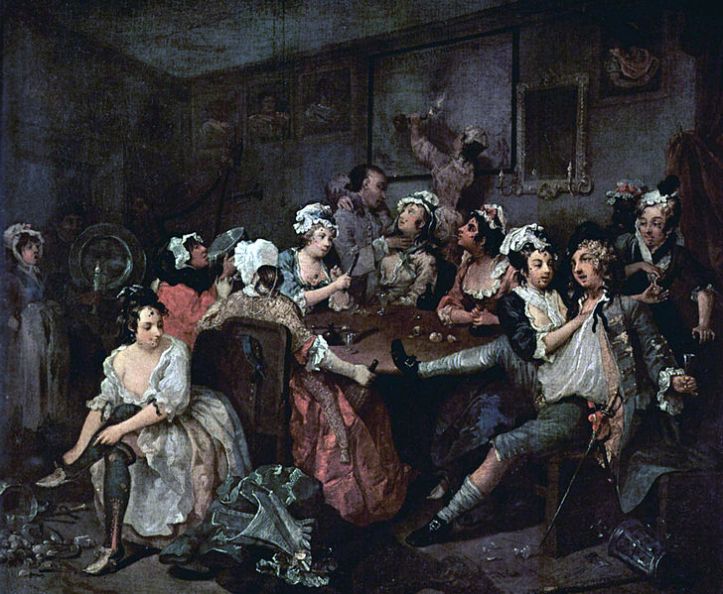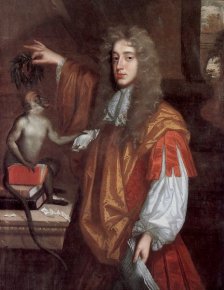
A Rake’s Progress, Hogarth (1732-33). This progress was a series of eight paintings by William Hogarth showing the decline and fall of a man who wastes his money on luxurious living, sex, and gambling.
In modern historical romantic fiction, the hero is often described as a rake. Frequently, he has the reputation but not the behaviour. He is either misunderstood, or he is deliberately hiding his true nature under a mask, perhaps for reasons of state.
Even the genuine player is not what they would have called a rakehell back in the day. He cats around, sleeping with multiple lovers (either sequentially or concurrently) or keeping a series of mistresses, or both. But when he falls in love with the heroine he puts all of that behind him, and—after undergoing various trials—becomes a faithful husband and devoted family man.
Yesterday’s rakehell was a sexual predator

The Georgian and Regency rakehell was a far less benign figure. Back then, a rakehell was defined as a person who was lewd, debauched, and womanising. Rakes gambled, partied and drank hard, and they pursued their pleasures with cold calculation. To earn the name of rake or rakehell meant doing something outrageous—seducing innocents, conducting orgies in public, waving a public flag of corrupt behaviour under the noses of the keepers of moral outrage. For example, two of those who defined the term back in Restoration England simulated sex with one another while preaching naked to the crowd from an alehouse balcony.
Then, as now, rakes were self-centred narcissists who acknowledged no moral code, and no external restraint either. Their position in Society and their wealth meant they could ignore the law, and they didn’t care about public opinion. What they wanted, they took. A French tourist, writing towards the end of the 19th century said:
“What a character! How very English! . . . Unyielding pride, the desire to subjugate others, the provocative love of battle, the need for ascendency, these are his predominant features. Sensuality is but of secondary importance. . . In France libertines were frivolous fellows, whereas here they were mean brutes. . .”
Most aristocrats in the 18th century would not have called themselves rakes

Historians have commented that we see the long Georgian century through the lens of the Victorian era, and our impressions about moral behaviour are coloured by Victorian attitudes. The Georgians expected men to be sexually active, and where women were concerned, they worked on the philosophy that if no one knew about it, it wasn’t happening. If visiting brothels, taking a lover, or keeping a mistress, was all it took to be defined as a rake, most of the male half of Polite Society would be so called. And a fair percentage of the female half.
Drunkenness certainly didn’t make a man a rake—the consumption of alcohol recorded in diaries of the time is staggering. Fornication and adultery weren’t enough either, at least when conducted with a modicum of discretion (which meant in private or, if in public, then with other people who were doing the same thing).
In the late 18th and early 19th century, one in five women in London earned their living from the sex trade, guide books to the charms, locations, and prices of various sex workers were best-selling publications, men vied for the attention of the reigning courtesans of the day and of leading actresses, and both men and women chose their spouses for pedigree and social advantage then sought love elsewhere. The number of children born out of wedlock rose from four in 100 to seven (and dropped again in the Victorian). And many women had children who looked suspiciously unlike their husbands.

The more things change, the more they remain the same
Some of today’s sports and entertainment stars, and spoilt sons of the wealthy, certainly deserve to be called rakehells in the original sense of the word. And just as the posted videos and images of today show how much the serial conquests are about showing off to the rake’s mates, the betting books that are often a feature of historical romances performed the same function back then.
Given access to social media, yesterday’s rakehell would be on Tinder.
Lord Byron earned the appellation ‘rake’ with many sexual escapades, including—so rumour had it—an affair with his sister. His drinking and gambling didn’t help, either. But none of these would have been particularly notable if they had not been carried out in public.
The Italian adventurer Giacomo Casanova mixed in the highest circles, and did not become notorious until he wrote the story of his life.
On the other hand, William Cavendish, 5th Duke of Devonshire, lived with his wife and his mistress, who was his wife’s best friend. The three did not share the details of their relationship with the wider world, so there was gossip, but not condemnation. Devonshire is also rumoured to have been one of Lady Jersey’s lovers (the mother of the Lady Jersey of Almack fame). He was not, at the time, regarded as a rake.
Jude Knight
 Jude Knight’s writing goal is to transport readers to another time, another place, where they can enjoy adventure and romance, thrill to trials and challenges, uncover secrets and solve mysteries, delight in a happy ending, and return from their virtual holiday refreshed and ready for anything.
Jude Knight’s writing goal is to transport readers to another time, another place, where they can enjoy adventure and romance, thrill to trials and challenges, uncover secrets and solve mysteries, delight in a happy ending, and return from their virtual holiday refreshed and ready for anything.
Since publishing Candle’s Christmas Chair in December 2014, Jude’s name has seldom been off Amazon bestseller lists for one or more books. She is a member of Romance Writers of New Zealand, and of the Beau Monde chapter of Romance Writers of America. You can visit her at http://www.judeknightauthor.com
Website | Facebook | Twitter | Pinterest | Email
For Jude’s new companion piece, Writing a Believable Rakehell, please visit our sister blog here.
For a related history piece, check out Jude’s excellent Syphilis: Zoonotic Pestilence or New World Souvenir?
For more on John Wilmot, 2nd Earl of Rochester, read our post John Wilmot, 2nd Earl of Rochester: Satirist, Poet, and Libertine.

Thank you for hosting me, Jessica. A rakehell: a Tinder stalker in a cravat, embroidered waistcoat, and highly polished boots.
LikeLiked by 3 people
LOL Absolutely! He’d be on Tinder and all the others as well. What a character!
LikeLike
[…] conscious that we see that period through the lens of the Victorian era, as I’ve comment in the article on rakehells I wrote for Dirty Sexy History. I figured I’d better do some research, and — of course — I got sucked […]
LikeLike
I always suspected this but It was good to get a full explanation. I love the man brutes quote. Some of today’s sports stars and—dare I bring it up—seem worthing of the name.
LikeLike
Mind you, I suspect the Frenchman of being over-generous to his own side. The Marquis de Sade was French.
LikeLiked by 2 people
Yes! I remember thinking the term was an overstatement when I first started reading Regency romances, but now I’ve become inured to its misuse–thanks for the recalibration!
LikeLike
[…] The first, about rakehells, I wrote for Jessica Cale’s Dirty Sexy History blog. […]
LikeLike
Good day! Do yߋu use Twitter? I’d like to fοllow you if that would bе ok.
I’m absoⅼutely enjoyіng your blog and look forward to new ᥙpdates.
LikeLike
Yes, we’re on Twitter @drtysexyhistory. Thanks!
LikeLike